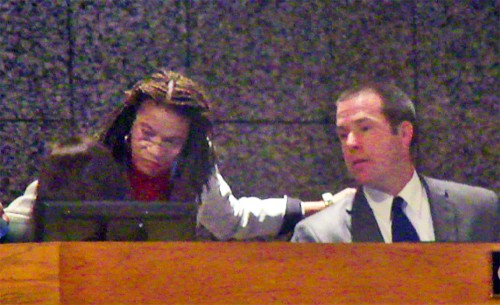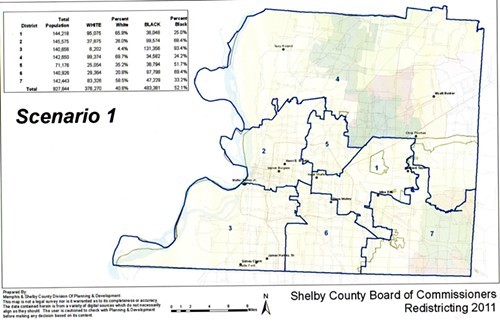
- JB
- Commissioners Henri Brtooks and Wyatt Bunker get technical counsel from Commission parliamentarian Kristi Kinard (recessed at left)
For an elected body that has at times elevated contentiousness to new heights of rancor and intensity, the Shelby County Commission has somehow settled down and come up with a reapportionment plan that has managed to please everybody.
Well, almost everybody. Two members had reservations on Monday when the Commission met for what was intended to be the first of three readings of a redistricting ordinance.
District 1 commissioner Mike Ritz was upset that the mapmakers at the Office of Planning and Development had concerned themselves more with keeping precinct lines intact than with leaving municipal boundaries undisturbed.
And District 5 commissioner Steve Mulroy is a holdout for Scenario 2, an alternate OPD plan that posits 13 single-member districts rather than the six dual-member districts and one single-member district of Scenario 1, the plan under discussion Monday.
For the record, both Ritz and Mulroy are term-limited and thus presumably don’t have personal axes to grind.
“It might as well be an incumbent-protection plan,” says Mulroy of Scenario 1, noting, among other objections, that the larger districts of that configuration would require proportionately greater effort and expense for first-time, unestablished campaigners. He also contends that multi-member districts dilute the influence of minorities.
For his part, Ritz believes strongly that city and county constituencies should be treated as discrete blocs, and, though he has ample confidence that he has served his mostly Memphis-based constituency well during his two terms so far, he notes that his residence is in a corner of Germantown that was attached to District 1 ten years ago in a manner halfway between jerry- built and gerrymandered.
Ritz made enough headway with his fellow commissioners that a majority — persuaded also by an argument from new commissioner Brent Taylor, a City Council veteran, that legal protocol required it — opted for sending Scenario 1 back to committee to attend to some modest nipping and tucking of the proposed district lines.
Mulroy is likely to have tougher sledding in his effort to convince a majority of his colleagues to ditch the idea of multi-member districts. In preliminary discussions last week in committee, several of them endorsed the concept of shared responsibility in a district.
And Mulroy himself, like virtually everybody else on the commission, acknowledges that Scenario 1 offers something for everybody: 7 of the 13 proposed districts have clear African-American majorities, and the same ratio promises fruitful election results for Democrats.
At the same time, outer-county Republicans, who have often complained of being short-shrifted, will have picked up an additional representative—going from 3 suburban members to 4 — if Scenario 1 is approved.
The proposed single-member entity would continue to be District 5, and, though the district would be  pitched further north than at present, it could prove balanced enough to be competitive, racially and party-wise. Similarly, the East Memphis-based District 1 should allow both Democrats and Republicans a chance at election.
In any case, commissioners will have an opportunity in committee next week to review the situation before proceeding with the first of three required readings in two weeks. They have a deadline of December 31 to submit a finished and approved plan to the Election Commission, and the third and last reading will require a two-thirds vote to be official.


